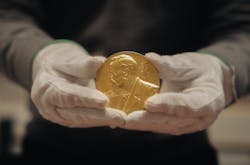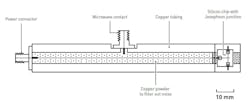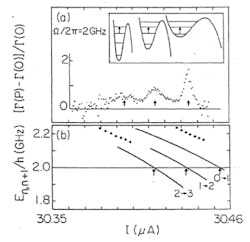2025 Physics Nobel Prize Awarded for Large-Scale Electron-Tunneling Insight
What you'll learn:
- The nature of quantum-based atomic-particle and electron tunneling.
- Why particle-level tunneling was the only known type for many decades.
- How this year’s Nobel Prize winners took tunneling from a microscopic level to a macroscopic level.
Unlike some years in which the Nobel Prize in Physics recognizes extremely large-scale but somewhat abstract events, such as the confirmation of gravity waves via the LIGO experiment, this year’s award has a direct connection and relevance to electronics.
On October 7, the Royal Swedish Academy of Sciences awarded the Nobel Prize in Physics to John Clarke, Michel H. Devoret, and John M. Martinis (all from the USA) “for the discovery of macroscopic quantum-mechanical tunneling and energy quantization in an electric circuit.”
Their work, mostly done in the 1984 to 1985 period, addressed a long-standing quantum-physics question: What is the maximum size of a system that can demonstrate quantum-mechanical effects such as electron tunneling? The prize winners conducted experiments with an electrical circuit in which they demonstrated both quantum-mechanical tunneling and quantized energy levels in a system big enough to be held in the hand.
Tunneling Down into Quantum Tunneling
The foundations of quantum mechanics were established exactly 100 years ago, but many of its strange implications have taken decades to unravel. Quantum tunneling — a phenomenon in which particles pass through a barrier that they shouldn’t have enough energy to overcome according to classical physics — is one of these.
Tunneling explains radioactive decay in which an alpha particle (consisting of two protons and two neutrons) still has a small probability of escaping the nucleus, despite being confined inside an atom (Fig. 1). Another is quantum superposition, in which an object can exist simultaneously in several places.
Both tunneling and superposition were known to occur at the atomic scale, but they hadn’t been observed in macroscopic systems before the prize winners’ experiments. Our world of solid-state devices explicitly uses tunneling in the tunnel diode (also known as the Esaki diode) as well as for other nanoscale-level transistor effects.
What are Cooper Pairs?
The question the prize winners explored was whether quantum-mechanic effects would be obeyed by these large systems. In a normal conductor, electrons move semi-randomly and bump into each other and the conductor material. When the metal becomes a superconductor, the electrons pair up in what are called Cooper pairs (not “copper” pairs) and form a current in which there’s no conductor resistance.
Cooper pairs can behave as if they’re a single particle that fills the entire circuit. Quantum mechanics describes this collective state using a “shared wave” function.
The properties of this wave function played a key role in the experimental work of the prize winners. The trio set up an experiment in which two superconductors were separated by a thin barrier, known as a Josephson junction (itself related to anther Nobel Prize award and now used as a super-sensitive detector) (Fig. 2).
In this configuration, the system's billions of Cooper pairs acted as a single particle that filled the entire test chip, flowing in a supercurrent with zero resistance. In classical physics, the system would remain stuck, unless given enough energy to escape.
By carefully monitoring the system and slowly increasing the current, Clarke, Devoret, and Martinis showed that the entire tiny circuit could break out into a higher-energy state, which they observed via a voltage spike (Fig. 3).
Royal Academy Explanations on the Prize-Winning Tech
While this is obviously a grossly simplified explanation, the Royal Academy has thoughtfully provided two more well-written technical discussions. The first one, at six pages, “Quantum properties on a human scale” is presented as a “Popular Science Background” (those are their words) and while free of equations, it’s not for the average person on the street.
The second one, at 15 pages, is presented as a “Scientific Background to the Nobel Prize in Physics 2025”and is far more technical and yet highly readable. It not only explains this year’s winning research but also provides meaningful historical background and context for it, as these advances and insights don’t just “appear” in a vacuum (no pun intended) — they build on the work of others.
Ironically and most likely a total coincidence, the same week that the Nobel Prize in Physics was announced, the annual Ig Nobel Prize in Physics was also presented at a live, raucous event at MIT. This year’s winner was a three-person team of professors from Italy for their work “for discoveries about the physics of pasta sauce, especially the phase transition that can lead to clumping, which can be a cause of unpleasantness.” See “Pasta Physics Scoops Up an Ig Nobel Prize” for details.
If you’re not familiar with the Ig Nobel Prizes, they’re satirical prizes awarded annually in various categories since 1991 to promote public engagement with scientific research. Its aim is to "honor achievements that first make people laugh, and then make them think" for discoveries "that cannot, or should not, be reproduced."
Many of the presenters at the ceremony are actual Nobel Prize winners, adding to the humorous credibility of the event. Some of the honorees have been awarded both Nobel and Ig Nobel prizes — a real double win!
References
Royal Swedish Academy of Sciences, “About the Nobel Prize."
Caltech Laser Interferometer Gravitational-Wave Observatory, "What are Gravitational Waves?"
About the Author

Bill Schweber
Contributing Editor
Bill Schweber is an electronics engineer who has written three textbooks on electronic communications systems, as well as hundreds of technical articles, opinion columns, and product features. In past roles, he worked as a technical website manager for multiple topic-specific sites for EE Times, as well as both the Executive Editor and Analog Editor at EDN.
At Analog Devices Inc., Bill was in marketing communications (public relations). As a result, he has been on both sides of the technical PR function, presenting company products, stories, and messages to the media and also as the recipient of these.
Prior to the MarCom role at Analog, Bill was associate editor of their respected technical journal and worked in their product marketing and applications engineering groups. Before those roles, he was at Instron Corp., doing hands-on analog- and power-circuit design and systems integration for materials-testing machine controls.
Bill has an MSEE (Univ. of Mass) and BSEE (Columbia Univ.), is a Registered Professional Engineer, and holds an Advanced Class amateur radio license. He has also planned, written, and presented online courses on a variety of engineering topics, including MOSFET basics, ADC selection, and driving LEDs.



